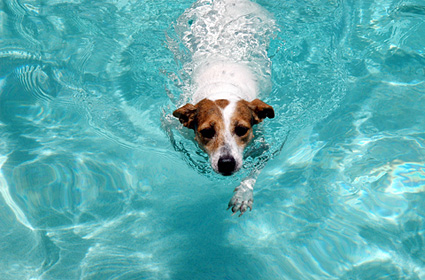Keep your dog safe from summer heat
We all love spending the long, sunny days of summer outdoors with our furry companions, but being overeager in hot weather can spell danger.
Check out these hot-weather tips to help prevent your pet from overheating.
- Pets can get dehydrated quickly, so give them plenty of fresh, clean water when it’s hot outdoors. Make sure your pets have a shady place to get out of the sun, be careful to not over-exercise them, and keep them indoors when it’s extremely hot.
- Never leave your animals alone in a parked vehicle.
Feel free to trim longer hair on your dog, but never shave your dog: The layers of dogs’ coats protect them from overheating and sunburn. - When the temperature is very high, don’t let your dog linger on hot asphalt. Being so close the ground, your pooch’s body can heat up quickly, and sensitive paw pads can burn. Heat rises from the ground, especially on surfaces like cement and asphalt, and dogs absorb and release heat through their feet, so slip on some dogie boots.
- Make sure to spray the paws and stomach, not just the top of the dog, when spraying it with water. A wet towel does more good on the bottom of your dog than when laid on the top of its coat.
Be sensitive to old and overweight animals in hot weather. Brachycephalic (snub-nosed) dogs those with heart or lung diseases should be kept indoors in air-conditioning as much as possible.
There are also various products like the HyperKewl doggie vests and mats that cool your pooch. You can browse through a few at www.rebeldog.cz
Know the warning signs
Symptoms of overheating in pets include excessive panting or difficulty breathing, increased heart and respiratory rate, drooling, mild weakness, stupor or even collapse. They can also include seizures, bloody diarrhea and vomit along with an elevated body temperature.
What to do if your dog gets overheated
- Move your pet immediately to a cool area – either into the shade or preferably into air conditioning.
When your dog seems more comfortable, call your veterinarian for next steps. - Provide cool water that’s not ice cold.
- Begin cooling procedures by soaking the body with cool water – cool, but not cold. Use a hose, wet towels or any other source of cool water that is handy.
- Concentrate the cooling water on the head and paws. You can slip on a frozen winter hat or cover paws with ice. (Make sure you use a towel to prevent a freezer burn!)
- Provide cool air for your dog to inhale. You can have your pooch breathe the air from an open freezer or air conditioning.

